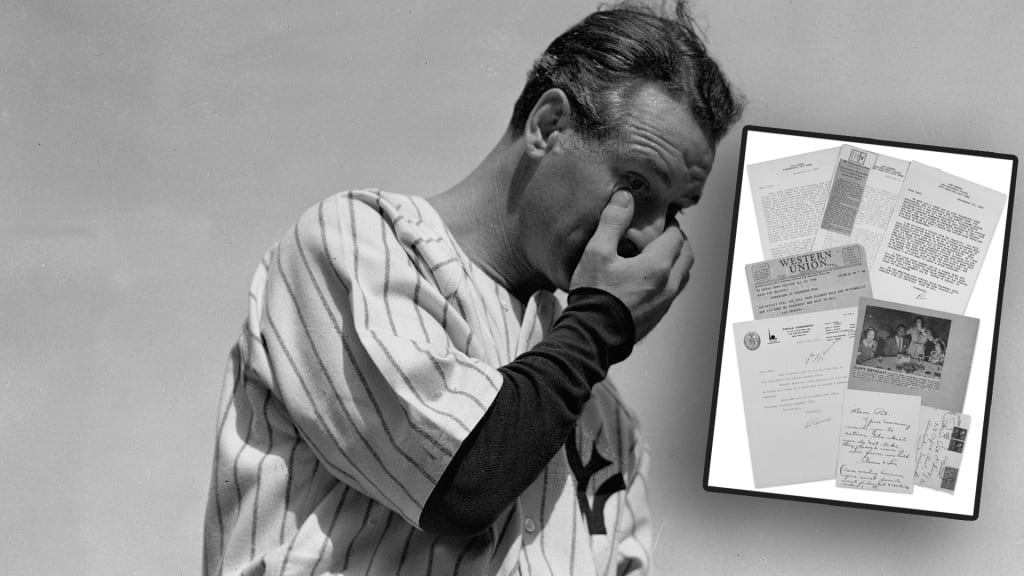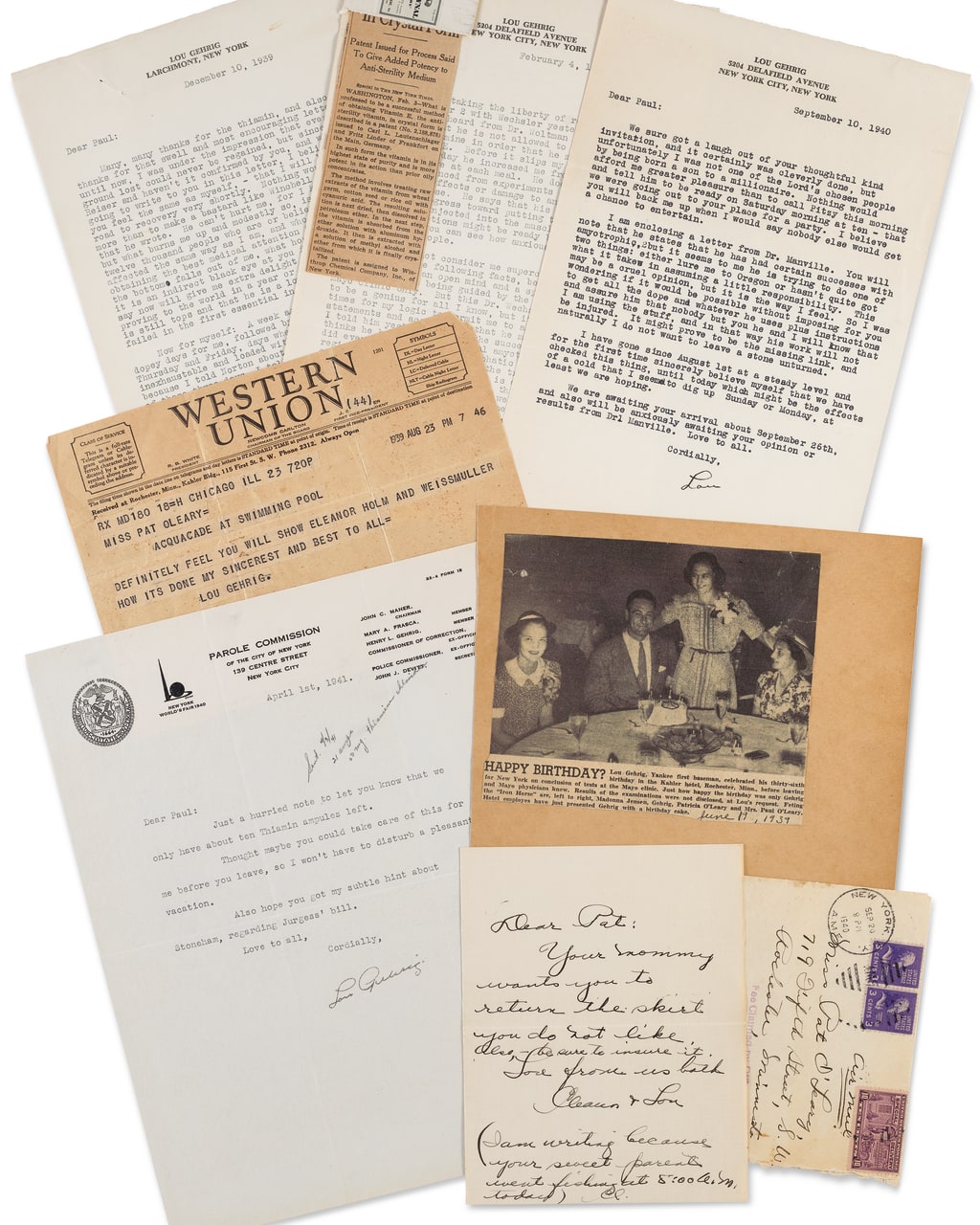
Lou Gehrig professed himself to be the “luckiest man on the face of the earth” as he stood before 61,000 fans at Yankee Stadium on July 4, 1939. And for decades, that famous speech served as the extent of what we knew about how Gehrig processed the so-called “bad break” that would take his life less than two years later.
But in more private moments, away from the adoring crowd that witnessed his valiant valedictory, how did Gehrig brave his bleak diagnosis with amyotrophic lateral sclerosis? Was the resoluteness of the “Luckiest Man” speech a fleeting front? How did the man once known as the “Iron Horse” really respond to his rapid demise at the hands of an awful illness that, to this day, remains incurable?
Thanks to the tireless research of Jonathan Eig, author of the 2005 biography “Luckiest Man: The Life and Death of Lou Gehrig,” we have answers to those questions. Eig is the one who uncovered the letters between Gehrig and his doctor that give us a deeper appreciation of the man Major League Baseball is celebrating with the first annual Lou Gehrig Day on June 2.

“He was,” Eig says, “a hero in every sense of the word.”
Back in 2003, when Eig was roughly two years into researching his book, he wasn’t necessarily able to make such a proclamation. To that point, Eig had found his subject to be admirable but ultimately unknowable.
Diagnosed with ALS at age 35 and deceased at 37, Gehrig had no children or siblings and wrote no memoirs. Gehrig’s widow, Eleanor, had passed away in 1984. While Gehrig’s baseball exploits had been covered extensively, precious little was known about the reclusive Gehrig’s private life, particularly his final years.
The above made the prospect of telling Gehrig’s story accurately a daunting one for Eig, who at the time was a reporter for the Wall Street Journal.
"I was really worried, 'What if he turns out to be a racist or a real jerk?'" Eig said.
He would have vivid dreams in which Gehrig was hitchhiking by the side of the road and would wave Eig off when he stopped to pick him up.
“I was nervous about whether I really understood him, because he was so shy,” Eig says. “There’s always a chance when someone is that quiet that you’re not really getting a picture of their true personality. The job of the biographer is to get as close as you can to know somebody. You’re bound to fail, but you just don’t want to fail too much. I was looking for anything I could find that would reveal clues about his personality.”
Eig’s search led him to the home of a collector in Libertyville, Ill., who had compiled hundreds of memorabilia auction catalogs going back a quarter century. Eig turned through those catalogs, page by page, looking for any reference to items related to Gehrig.
That’s how he found out about the existence of the Gehrig letters, which Christie’s had auctioned to an anonymous buyer in 1998. The correspondence between Gehrig and his Mayo Clinic physician, Dr. Paul O’Leary, had been in O’Leary’s possession until his death. They had never been published, and very few people knew they existed.
“I knew I could not turn this book in, could not publish it without seeing those letters,” Eig says. “I was prepared to put off the book as long as it took.”
It quickly became clear that it could take a while. Christie’s would not reveal the name of the buyer, who had paid $50,000 for the letters. Multiple letters sent to the buyer via Christie’s went unanswered.
“So I began calling every memorabilia collector I could find and asked if they bought [the letter collection],” Eig says. “Finally, I found somebody who said, ‘It wasn’t me, but I bid on it, and I remember the guy who beat me out was named Ancel.’”
With some Googling, Eig tracked him down: James Ancel, a Maryland construction company owner and baseball memorabilia collector. Well aware that Ancel was the one ignoring his letters and probably wanted nothing to do with him, Eig prepared his best and most heartfelt pitch and dialed the phone number.
“I made this very passionate, emotional speech about how important it is for the world to know what’s in those letters,” Eig says. “I said, ‘Gehrig is a hero and an inspiration and we need to know how he handled ALS. I could never finish this book and our knowledge would not be complete with that information.’”
Ancel’s response?
“OK, fine.”
With that, Eig gained access to more than 100 letters and telegrams that give us a fuller picture of the effects ALS had on Gehrig’s body and his psyche. Reading them, we see Gehrig desperately clinging to hope of a cure while generally being misled by his doctor about his chances of survival. We see his penmanship deteriorate and his thoughts vacillate between optimism and fear.
Above all else, we see that the courage and the humility demonstrated in the “Luckiest Man” speech was very much the real Lou Gehrig.
“Seem a little more secure in my legs,” he wrote to O’Leary just 12 days after his famous speech, “and in general feel great.”
Thus began correspondence that would last for months and encompass nearly 200 pages. O’Leary not only kept Lou’s letters, but also carbon copies of his replies. And so there is documentation of the course of the experimental therapies used on Gehrig, including histamines and vitamin E. O’Leary offered Gehrig disingenuous confidence that his condition could eventually stabilize.
In December of 1939, Gehrig wrote of an encounter with an orchestra conductor named Al Reiser who he said had been “similarly infected” with ALS and returned to normalcy within two years. Gehrig was understandably enthused about this prospect and wrote to O’Leary to ask his chances of a similar experience.
“I do not want to be a hero, and I would hate like hell to be a cry baby,” Gehrig wrote, “but I would also like to know the facts if any.”
O’Leary responded: “I was happy that Al Reiser and you got together, because I know by innuendoes you have the impression that people do not arrest the progress of amyotrophic lateral sclerosis. Al Reiser is just one of a group that have been improved and I trust that in seeing him you have been reassured that there is a damn good probability that you will do likewise.”
In subsequent letters, O’Leary told Gehrig, who was still going to work every day as a New York City parole commissioner, that he had a 45-percent chance of survival.
The doctor knew this was untrue, that no patient had survived ALS and that Reiser’s condition was probably a milder form of sclerosis. But throughout his correspondence with Gehrig, O’Leary maintained these illusions, likely in an effort to keep Gehrig’s spirits up and to maintain his famous patient’s cooperation with potential treatments.
This would appear problematic. A modern-day reading renders O’Leary’s tact as unethical. Yet it was actually a common practice in the medical field at the time. And O’Leary did it with the implicit encouragement of Eleanor Gehrig, who in her own letter to the doctor asked him to “lie like mad” and to maintain “a thread of hope” in order to avoid “adding mental torture to the horrible experience” Gehrig was enduring.
“I think a lot of that is natural and human nature and true even today for people who get a tragic diagnosis,” Eig says. “You grab onto anything you can, even the slenderest of hopes ... I don’t really blame his wife or doctors. We weren’t there to know what was going on emotionally and how they coped.”
The dance continued as Gehrig’s condition worsened, as his diction became slurred, as eating became difficult, as his hand muscles became paralyzed, as his pectoral muscles atrophied, as his legs shook in the night. He continued to press O’Leary for “honest opinions,” and O’Leary continued to stress the positive.
As the treatments failed to improve his condition, Gehrig wrote to the doctor not of his own battle with ALS, but of the health issues of his friends and family members. He sought input on Eleanor’s scalp and face rash, on songwriter Fred Fisher’s abdominal pain, on Giants shortstop Bill Jurges’ dizzy spells.
As in the “Luckiest Man” speech, we see Gehrig’s gentle and unpretentious nature, his care for others.
In other words, we see the real Lou Gehrig that Eig had been seeking.
“If he had been scared, if he had been depressed, of course that would be understandable," said Eig. "But he wasn’t. He really believed he was going to beat this thing. And when it became clear he wasn’t going to beat it, he focused his time and energy on helping others and looking for a cure and giving up his body to science.”
In one of Gehrig’s final letters to O’Leary, he wondered “how much further this thing can go.”
“Don't think that I am depressed or pessimistic about my condition at present,” he wrote. “I intend to hold on as long as possible and then, if the inevitable comes, I will accept it philosophically and hope for the best. That's all we can do."
Gehrig died five months later, on June 2, 1941.
With so much lost to time, the contents of these letters are a vital connection to a baseball legend and an icon in the ongoing fight against ALS. The letters themselves were recently auctioned off by Christie’s again. In December of 2020, they sold to an anonymous buyer for $450,000 -- a healthy markup from the price Ancel paid in 1998. (Because he no longer owns the letters, Ancel declined to comment for this story.)
As a lifelong Yankees fan, Eig admits he didn’t fully appreciate Gehrig in his youth. Babe Ruth, Joe DiMaggio and Mickey Mantle were the more magnetic Bronx Bomber legends, while Gehrig was the quiet guy who played every day and died young.
Only when he reached his mid-30s himself did Eig truly understand how much life Gehrig had left to live, how tragic his story was. And in finding Lou’s letters, Eig did his part to ensure all of us have a greater sense of that story.
“You feel like it’s the most important story you’re ever going to tell,” Eig says, “because it’s somebody you love and admire.”
Lou Gehrig Day is an opportunity for all fans to delve deeper into that story and to better understand the Iron Horse’s legacy. Because so little advancement has been made in the treatment of ALS, the story remains as vital today as it was when Gehrig stepped to the microphone and delivered the “Luckiest Man” speech in 1939.
“People don’t live with ALS for very long,” Eig says. “You don’t have this great army of volunteers and survivors that you do with many forms of cancer, where those people continue to advocate and raise money for the cause. So the ALS community still needs Lou Gehrig.”
Thanks to the letters, a piece of him is still present.
